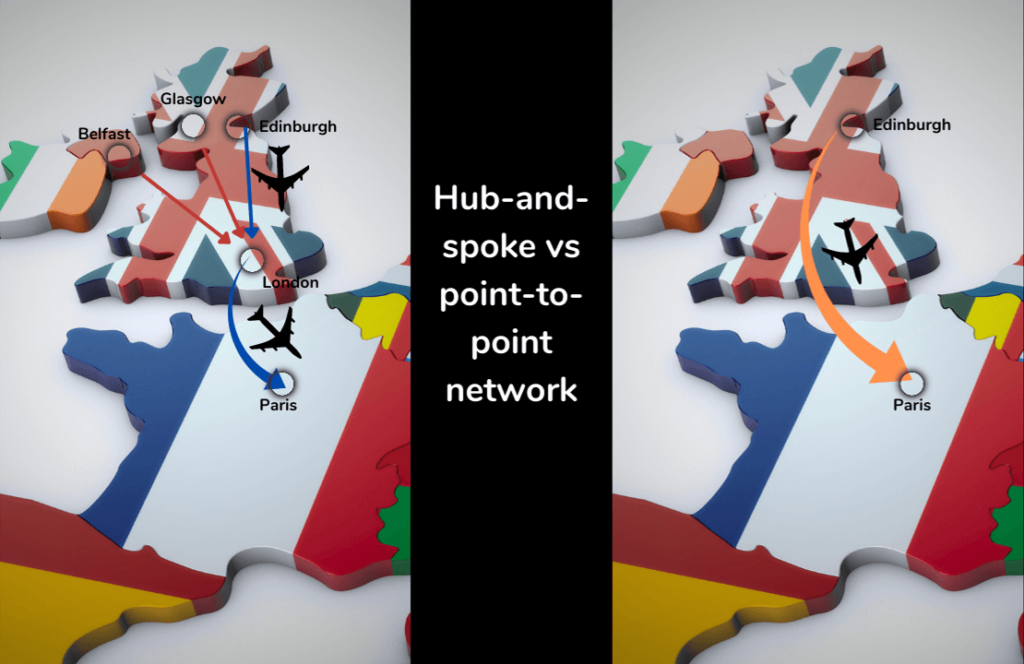What makes an airline
Commercial airlines are complex beasts. They comprise of multiple intertwined (and siloed!) functions that make the business work. As passengers, we see a “tip of the iceberg” when we fly. A lot of work goes into making that flight happen, which starts well in advance.
Let’s distil the complexity into something more digestible and highlight how data is driving the decisions.
There really are just four core components to every commercial airline:
- What type of airline it is – business model and strategy
- Route network – where and how often you fly
- Revenue – matches demand to supply
- Safe and efficient operations – gets you to your destination safely, reliably, while not costing more than the revenue collected (ideally by some margin)
The airline must get all four areas right to be successful.
- If your strategy is low cost and your product is not, the airline will go bust.
- If the route network is not where the customers want to fly, there won’t be any customers.
- If the routes are popular, but highly competed, there will not be enough revenue.
- And if the operation is cumbersome and inefficient (let alone unsafe!), the revenue will not be able to cover the expense.
I will cover all four core functions over the next few blogs.
Today, let’s focus on the network planning. It’s closest to my heart.
Airline business models
Route network drives the airline. It determines what type of operation is required to deliver the program and what revenue there is available to collect. The network is never static, constantly affected by a multitude of factors, such as product fine tuning, competition, airline growth, aircraft availability, operational constraints, alliances, geopolitical impacts, etc.
No airline ever gets the network right 100%, but the profitable ones will have a solid proportion of their routes covering the margin. Lots of data underpins the decision-making process. Yet, network planning is as much an art as it is science. A perfect blend of human expertise and data.
Network design reflects the company’s strategy, which in turn depends on the business model of the airline. There are various business models in existence:
- full-service (long/short haul)
- low-cost carriers (LCC)
- regional (smaller planes and shorter, more localised network)
- charter
- tour operators
Each model will have a different strategy and thus a different take on their route network. What works for a low-coster may not at all be appropriate for a full-service airline and vice versa. Full-service carriers tend to operate hub-and-spoke networks (feeder), where all routes congregate into a central “hub” airport and make connections to other flights there. Whereas an LCC is predominantly point-to-point (p2p), flying passengers directly between two airports.
Regional carriers will have a mixture of p2p and feeder products that primarily serve business and commuter traffic in a locality and provide connecting passengers to full-service airlines in hubs. Charters and tour operators considerably scale up their operations on leisure routes for holiday seasons but fly very little outside of them.
Who flies what
Each model will have a different strategy and thus a different take on their route network. What works for a low-coster may not at all be appropriate for a full-service airline and vice versa. Full-service carriers tend to operate hub-and-spoke networks (feeder), where all routes congregate into a central “hub” airport and make connections to other flights there. Whereas an LCC is predominantly point-to-point (p2p), flying passengers directly between two airports.
Regional carriers will have a mixture of p2p and feeder products that primarily serve business and commuter traffic in a locality and provide connecting passengers to full-service airlines in hubs. Charters and tour operators considerably scale up their operations on leisure routes for holiday seasons but fly very little outside of them.

LCC vs Full Service Carrier
Let’s take one example. If you were going from Edinburgh to Paris, British Airways (hub airline) will take you to their hub at Heathrow first and then put you on a connecting flight to Paris. Whereas easyJet (LCC) will fly you direct. By being low-cost, easyJet can charge lower fares, thus stimulating enough demand on the route to fill the aircraft profitably. British Airways, on the other hand is less reliant on direct demand. It can pool passengers from various other flights onto its Paris leg. Neither model is “better”, just serve different strategies. And so, the route tactics will be different for both carriers.
When a new competitor comes to this route, both BA and easyJet could decide to fight it. If the fight is on a point-to-point basis, then easyJet will stand to lose more, so chances are they will be more proactive. They could decide to add more capacity, lower prices and change timings to make their offering more appealing than the competitor’s. They will take a profit hit over some period in hopes that the competitor withdraws, or enough new demand is stimulated by additional capacity and cheaper prices to later justify fare increases.
BA, on the other hand, may decide to stay completely out of it and make no changes to the product at all, because they only have a small percentage of the traffic going to Paris on their flights. BA will fight much more fiercely on their core, cash cow long-haul routes like New York, however. In both cases, thorough business cases will be developed to support the decisions. Such things are never taken lightly.
These illustrate just some of the activities that network planning does.
Network planning
The planning phase normally starts well over a year in advance (some carriers do two or more years ahead). The main reason for that is to maximise the size of the selling window. If you plant to fly a route in twelve months’ time, you should ideally have it on sale no later than nine months ahead. It takes time to fill up the seats.
However, another reason to start so early is to give the planners enough time to collect and analyse vast amounts of data. The data resides in various internal and external systems and involves close collaboration of just about every airline department, from RevMan to IT to Ops to Finance to Procurement to Marketing and Sales. An intricate web of data and expertise coming together under one umbrella. It takes months of effort to do, especially considering that the planning teams are generally lean.

The process kicks off with an evaluation of the current financial performance and anything that might be impacting it, such as demand fluctuations, competition, schedules, slots, available seat capacity, cost base impacts from fuel price, airport charges, crew costs, maintenance, ATC, disruption, etc. The more mature the airline, the more parameters they will take into consideration.
All routes are measured against a profitability target. Airlines will have different ones (revenue, operating profit, EBITDA, etc) but the goal is the same – they either make money or they don’t. Route profitability makes or breaks the airline. It is the sole material source of revenue and pays for everything else.
Many airlines are not profitable and get bailed out, bought out or require restructuring. Zombie airlines. Occasionally, they even go bust (quite rare!). Aviation is a cyclical industry, meaning it gets good and bad revenue years. The lower the cost base, the easier it will be ride out the bad times (and be very profitable in good ones!). Those who do not have razor-sharp control of their cost base inevitably fail. Short term hits to profitability are sustainable, but few can take chronic pain and survive. A well-designed route network goes a long way in helping the airline stay profitable.
There are lots of tricks and recipes that go into evaluating what routes an airline should operate. At the heart of the analysis are copious amounts of data. You must consider things like the market demand, take-off and landing slot availability, operating costs, ops performance, competitor scene (airlines, trains, cars), customer segmentation (business/leisure/VFR), attractiveness and catchment areas, days/times of operation, regulations, etc. There are never enough data sources when it comes to route analysis. The more you know about the customer and product, the higher the chances of success. The more data you need, the longer it takes to obtain and analyse it.
Route selection
The core of the network plan comes from the analysis of the existing routes that already have trading and operational data available, so it is used as a baseline. What you would normally evaluate here is product adjustments (fly more/less, turn it into a business product or leisure) and timing changes. You will already have a feel for your customer behaviour and the revenue pool, so you can better gauge what changes improve profitability. Chronically underperforming routes get churned out.
New routes are a whole other beast. This is where science intertwines with the art part. I’ve known airlines that decided new routes by pointing a finger on the map. This is not common though. A good network planning department will spend months researching dozens of new routes before creating a short list. New routes always carry a higher risk for an airline because they take about three years to mature before becoming fully profitable. Thus, each new route comes with a full business case and a rigorous sign-off.
Once the shape of the network is decided, it is passed on to scheduling, revenue management and operations to bring the program to life. Data is again a key component of that process. I will cover this phase in the next blog.
Network data and tools
Network planning departments tend to develop custom, in-house analytical tools, covering all aspects of the route planning and management processes. They are normally owned and maintained by the SMEs, albeit productionising them should be strongly considered. Sometimes, we gave the tools affectionate names. One we used back in the day was called the DUDE (in honour of the Big Lebowski’s Dude), which stood for “Damn Useful, Does Everything”. It measured many aspects of the existing route performance and informed decisions. It also took a long time to update and maintain.
One thing I always wished we had (but never did due to dev time and resource constraints), was more data automation. 80% of the planning data was the same. But it’s shape, quality and completeness were always an issue. Automating its collection, transformations and quality checks, etc. should be fully autonomous, surfaced at a press of a button.
There were many other data sources that we hardly used due to the sheer complexity of getting the data into a usable state. This is yet another area we @IOblend have developed now to shorten the data collection and management phases by several months to give the network planners more quality time for doing analytics. The key benefit is that the planners themselves create their production-grade data pipelines without burdening the engineering teams, no matter how complex. It’s a game changer.
Network planning is not a static function. New challenges constantly arise. The teams must be able to analyse new events faster with better data and bring in new technologies like AI. If you are doing network planning and experience similar challenges to the ones described above, get in touch and let’s discuss how we can help you.
Enhancing airline route network planning and analytics significantly relies on a data-driven approach, integrating varied data sources, and utilizing advanced analytical tools. Commercial airlines, characterized by their complexity and diverse business models—ranging from full-service to low-cost carriers—demand intricate network planning strategies. IOblend’s solutions facilitate this by leveraging real-time analytics and data mesh architectures. These tools and methodologies enable airlines to adapt their networks dynamically, considering factors such as market demand, competition, aircraft availability, and regulatory constraints. By harnessing the power of deep data insights, airlines can make informed decisions, optimizing their route networks for efficiency, profitability, and enhanced passenger experiences.

Real-Time Risk Modelling with Legacy & Modern Data
Risk Modelling in Real-time: Integrating Legacy Oracle/HP Underwriting Data with Modern External Datasets 💼 Did you know that in the time it takes to brew a cup of tea, a real-time risk model could have processed enough data to flag over 60 million potential fraudulent insurance claims? The Real-Time Risk Modelling Imperative Real-time risk modelling is

Unify Clinical & Financial Data to Cut Readmissions
Clinical-Financial Synergy: The Seamless Integration of Clinical and Financial Data to Minimise Readmissions 🚑 Did You Know? Unnecessary hospital readmissions within 30 days represent a colossal financial burden, often reflecting suboptimal transitional care. Clinical-Financial Synergy: The Seamless Integration of Clinical and Financial Data to Minimise Readmissions The Convergence of Clinical and Financial Data The convergence of clinical and financial

Agentic Pipelines and Real-Time Data with Guardrails
The New Era of ETL: Agentic Pipelines and Real-Time Data with Guardrails For years, ETL meant one thing — moving and transforming data in predictable, scheduled batches, often using a multitude of complementary tools. It was practical, reliable, and familiar. But in 2025, well, that’s no longer enough. Let’s have a look at the shift

Real-Time Insurance Claims with CDC and Spark
From Batch to Real-Time: Accelerating Insurance Claims Processing with CDC and Spark 💼 Did you know? In the insurance sector, the move from overnight batch processing to real-time stream processing has been shown to reduce the average claims settlement time from several days to under an hour in highly automated systems. Real-Time Data and Insurance

Agentic AI: The New Standard for ETL Governance
Autonomous Finance: Agentic AI as the New Standard for ETL Governance and Resilience 📌 Did You Know? Autonomous data quality agents deployed by leading financial institutions have been shown to proactively detect and correct up to 95% of critical data quality issues. The Agentic AI Concept Agentic Artificial Intelligence (AI) represents the progression beyond simple prompt-and-response

IOblend: Simplifying Feature Stores for Modern MLOps
IOblend: Simplifying Feature Stores for Modern MLOps Feature stores emerged to solve a real challenge in machine learning: managing features across models, maintaining consistency between training and inference, and ensuring proper governance. To meet this need, many solutions introduced new infrastructure layers—Redis, DynamoDB, Feast-style APIs, and others. While these tools provided powerful capabilities, they also

